Content created: 2011-02-26
File last modified:

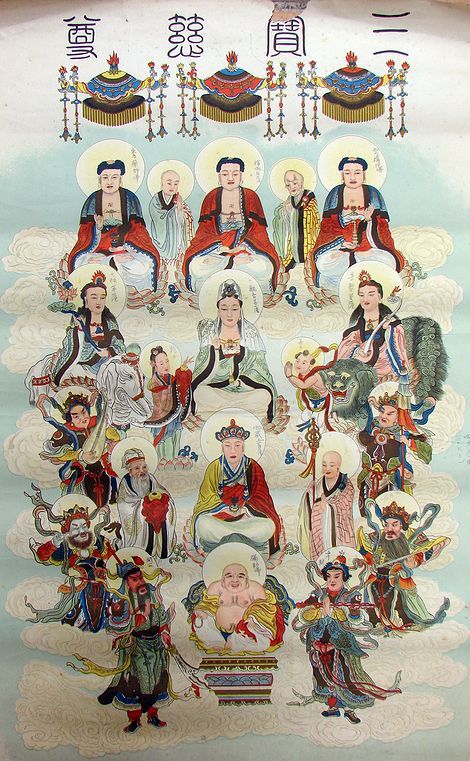
A Beginner's Guide to
Chinese Temple Images
Illustrated by a Retablo Wall Poser
Skip to Row
1
2
3
4
This page is designed to help you recognize some of the figures most commonly represented on Chinese Buddhist altars or paintings. The basic picture used here is a cheap paper retablo (definition) from the 1970s, intended to be hung on the wall over a very simple home altar in Taiwan. Thousands of these are sold every year, so it is very much part of "vernacular" Buddhism, i.e., Buddhism as it is actually practiced. The retablo includes the figures you are also likely to see in statuary in a Chinese Buddhist temple.
Larger temples will normally have statues corresponding to every figure on this page, plus statues of arhats (disciples of the Buddha), for which this web site includes a separate page. (Link.)
The inscription across the top of the retable reads (right to left): Sān Bǎo Xǐ Zūn 三寶喜尊 (三宝喜尊), "Felicitous Worthies of the Three Treasures." (The three treasures are the Buddha, Buddhist teachings, and the Buddhist clerical community.)
A Chinese Buddhist monk kindly identified most of the figures and used a pencil to write the names on the halos. He made a couple of mistakes, which have been corrected in the text, but not in the pictures. As you look through this page, can you find his mistakes?
Row One: Three Great Buddhas
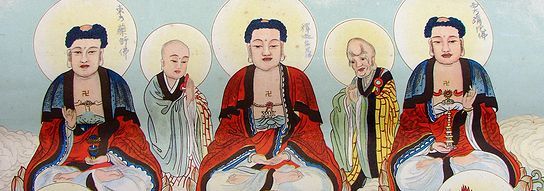
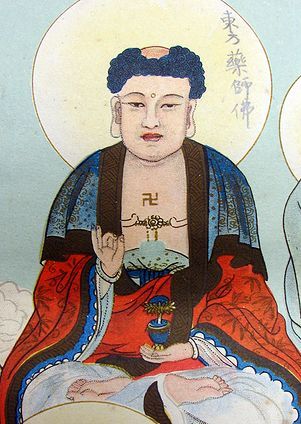
- Left: Yàoshī fó 药师佛
("Buddha of Healing"
or "Medicine Buddha")
(Vaidurya Buddha)
- This figure is believed to have received from Shìjiā fó (next entry) the power to heal all illness. It became a widespread belief that healing could be attained by touching a statue of the Medicine Buddha corresponding to an afflicted place one one's own body, and then touching the afflicted spot, conveying the buddha's healing to it. In art he is sometimes shown, as here, holding a small pot of medicine.

- Center: Shìjiā fó 释迦佛
or Shìjiāmóuní fó 释迦牟尼佛
(Sākyamuni Buddha).
- This is the historical buddha, who lived in the India-Nepal border region about 500 BC. Sākyamuni means "Sage-of-the-Shakya-Clan."
(Story Link: The Life of the Buddha)
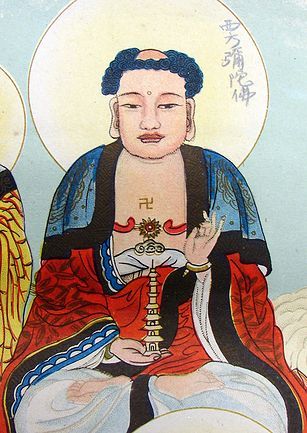
- Right: Ēmítuó fó 阿弥陀佛
("Boundless Light Buddha").
(Amitābha Buddha)
- He is associated with the "Pure Land" or Jìngtǔ 净土 (Sukhavati), in which all beings will enjoy unbounded happiness who sincerely call upon his name by the time they die. Ēmítuó fó is one of the most popular figures in Chinese Buddhism.
The two other figures in this row are arhats (luóhàn 罗汉), or disciples of the Buddha. The younger one on the left is the Buddha's favorite disciple Ēnán 阿南 (Ānanda), and the older one on the right is his oldest disciple, Jiāyè 迦叶 (Kassapa) (Arhat Number 17).
(Story Link: The Eighteen Arhats.)
Return to top
Row Two: Three Great Bodhisattvas
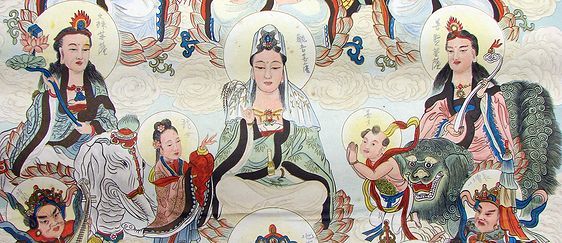
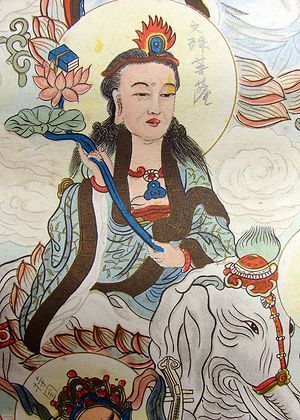
- Left (Seated on a white elephant):
Pǔxián púsà 普贤菩萨
("Universally Worthy Bodhisattva")
(Samantabhadra Bodhisattva, also called Visvabhadra Bodhisattva)
- He is the púsà associated with conduct, representing the doctrine or "law." He has Ten Great King Vows, which are the guidelines in practicing Buddhism, and cultivating the Buddhist way. He is often placed at the right-hand of Shìjiā fó, riding a white elephant.
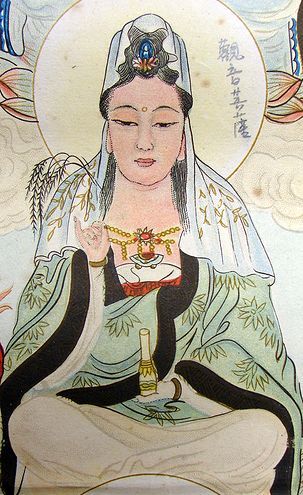
- Center: Guānyīn púsà 观音菩萨
or Guānshìyīn púsà 观世音菩萨
("the Bodhisattva who Hears the Cries of the World")
(Avalokitesvara Bodhisattva)
- Guānyīn was originally represented as male, but is today usually pepresented as female (or androgynous) in China, perhaps the successor to a pre-Buddhist goddess of mercy or of childbirth. Particularly associated with compassion and mercy, s/he rescues all beings by hearing the sounds of their suffering and their cries for help. Guānyīn is often associated with Ēmítuó fó (whose image usually appears in her headdress), and with the ability to appear in many different forms in order to accomplish the work of salvation. For example, under the name Báiyī Dàshì 白衣大士 ("Great White-Robed Scholar") she is shown carrying a child and is prayed to for children. But as the Dàxióng 大雄 ("Mighty Hero") she battles on behalf of Buddhism. Guānyīn is the most popular bodhisattva in China, and a continuing flow of popular-culture materials fuel constant new foci for her cult.
(Story Link: Thousand-Armed Guānyīn )
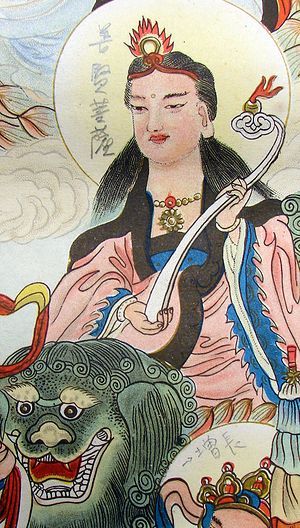
- Right: (Seated on a blue lion):
Wénshū pǔsà 文殊菩萨
(Mañjuśri Bodhisattva).
- He is associated with wisdom and is said to have wonderful head in acknowledgement of this. Wénshū is often placed at Shìjiā fó's left hand and is represented as riding a blue lion. He is also described as the ninth predecessor or buddha-ancestor of Shìjiā fó, the chief of the bodhisattvas, or the chief disciple of the Buddha.
The two smaller figures in this row are young male and female "attendant spirits" (shìshén 侍神) to Guānyīn, frequently shown accompanying her. They are usually referred to simply as "Dragon Girl"(Lóngnǚ 龙女) and "Virtuous Talent" (Shàncái 善才).
(Some people write this last name with the homonymous characters 善财, "Virtuous Wealth.")
Return to top
Row Three: The Realm of the Dead & the Guardians of Buddhism
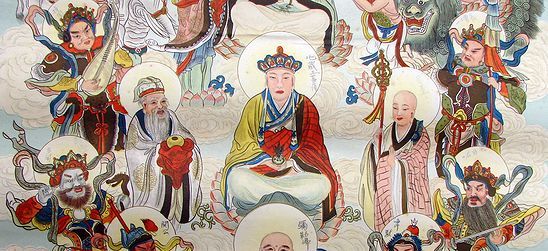

- Left (holding bowl):
Duke Mǐn (Mǐn gōng chángzhāi 闵公长斋) - A fervant Buddhist who donated land for a temple complex for Dìzàng (below) and eventually gave up his kingdom to become a monk, asking his own son,already a monk, to be his teacher. (The title chángzhāi means "permanent vegetarian," a title assumed before he became a full monk.) (Story Link: The Tale of Duke Mǐn & Dàomíng)
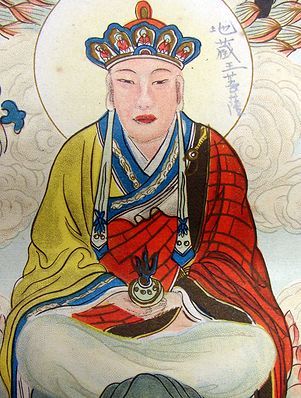
- Center: Dìzàng wáng púsà 地藏王菩萨
("Earth Treasury King Bodhisattva")
(Kṣitigarbha Bodhisattva)
- He is associated with hell (purgatory) and the souls suffering the karmic results of their wickedness. Dìzàng is sometimes considered to be a reincarnation (or pre-incarnation) of Yánluó wáng 阎罗王, the ruler of the Fifth Court of Hell and general chief of that realm, but in art he is usually represented separately. As a figure bringing sympathy to those who need it most, he does not intervene in hell's justice, but tales describe him as ensuring its compassion.
(Text Link: The Jade Guidebook A Visitor's Guide to Hell.)
(Text Link: Two Tales of the Bodhisattva Dìzàng)
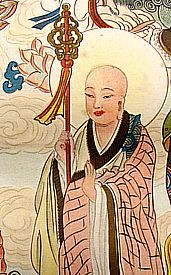
- Right: Dàomíng zūnzhě 道明尊者
- Although the title zūnzhě normally refers to an arhat, the young man beside Dìzàng is a prince who became a monk under Dìzàng's influence and later became the teacher of his own father, Duke Mǐn (above). (Story Link: The Tale of Duke Mǐn & Dàomíng) He is always represented as looking exactly like Mùlián 木莲, the disciple of the Buddha famed for descending into hell to save his mother. (Story Link: How Mùlián Saved His Mother) A few scholars hold that they are identical.
- The Two Sides: Celestial Kings
- Surrounding these figures are four "Celestial Kings" (Tiānwáng 天王) or "Diamond Kings" (Jīngāngwáng 金刚王). It is common to mix up their names, and they are mislabeled in some books and even some temples. They are guardians of Buddhism, borrowed from Indian mythology (where they are called digpalas or lokapalas). They guard the Buddha —but more broadly they also guard Buddhist institutions— against demons. Each bears an iconographic symbol (sometimes understood as a magical weapon), but the frequent confusion about who's who suggests that these symbols function collectively to identify the four rather than individually to differentiate them. They are:
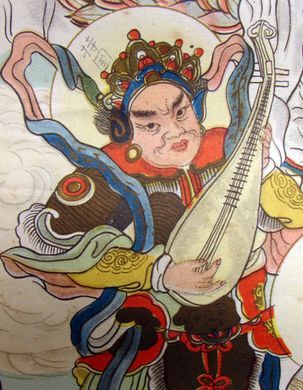
- Upper Left
(Carrying a pípá 琵琶, a kind of guitar):
Chíguó tiānwáng 持国天王
("The Celestial King Who Sustains the Nation")
(Dhriarastra, guardian of the east)
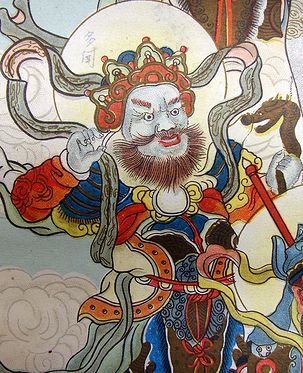
- Lower Left
(Carrying a dragon and sometimes a sword):
Guǎngmù tiānwáng 广目天王
("The Celestial King With Wide Vision")
(Virupaksa, guardian of the west, including relics of the Buddha.)
- The dragon he is shown with in Chinese art is almost certainly related to the nagas or snakes understood as protectors of the faith in Southeast Asian Buddhist art.
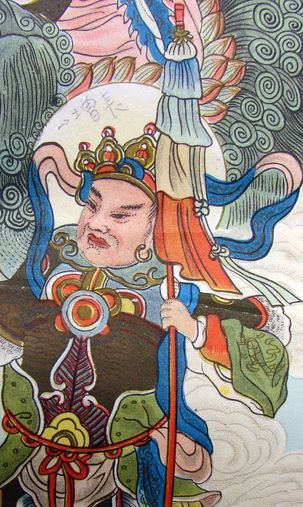
- Upper Right
(Carrying an umbrella):
Duōwén tiānwáng 多闻天王
("The Celestial King Who Listens Much")
(Jambhala = Vaishravana = Kubera, guardian of the north)
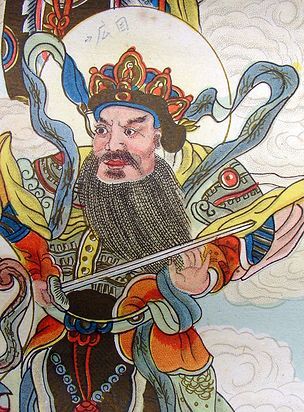
- Lower Right
(Carrying a Sword and sometimes a ring):
Zēngcháng tiānwáng 增长天王 (Virudhaka, guardian of the south) ("The Celestial King Who Lengthens [Life]")
Return to top
Fourth Row: The Buddha of the Future & More Guardians
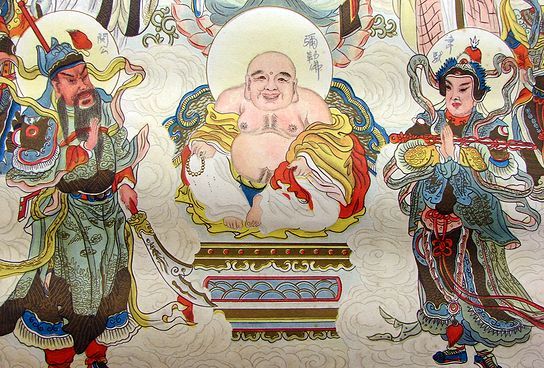
- Left: Guāndì 关帝
(=Guāngōng 关公 = Guān Yǔ 关羽)
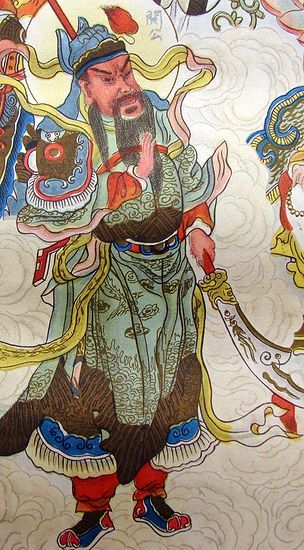
- This important general from the Three Kingdoms period at the breakup of the Hàn 汉 dynasty (period 6) is associated primarily with justice, moral integrity, and being true to one's word, and hence he is the patron of oaths and brotherhoods, but also of merchants, armies, policemen, and even rebels. Tradition holds that after he was beheaded he appeared to a friend who was a Buddhist priest and claimed that after death he had become a Buddhist. On the strength of this tradition, he is regarded as one of the divine protectors of Buddhism, and he is often paired, as here, with Wéituó, another protector divinity.
(History Link: The Three Kingdoms Period)
- Center: Mílè fó 弥勒佛
(Maitreya Buddha)
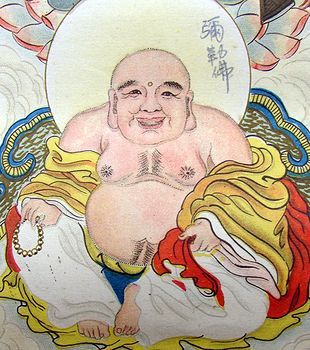
- He will be the next buddha in our world. He is usually represented as the fat laughing monk, a form modeled on the "cloth bag monk," a tenth-century beggar sometimes described as Mílè's "pre-incarnation" but also included as number 13 among the 18 arhats. The buddha preceding Shìjiā fó was called the "Lamplighter Buddha" Rándēng fó 燃灯佛. The three are occasionally seen together.
(Background Link: The Maitreya Buddha)
- Right: Wéituó púsà韦驮菩萨
(Skanda Bodhisattva)
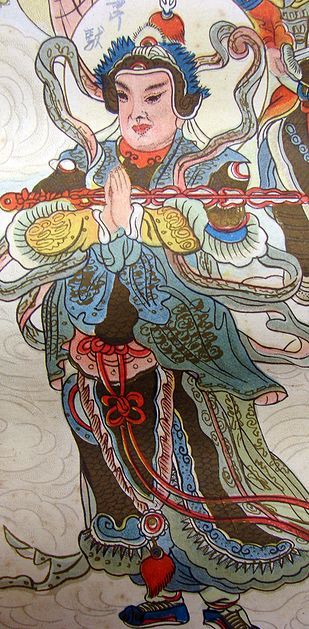
- He is regarded as a "dharma protector god" (hùfǎ shén 护法神) and is considered to be the commander of twenty-four celestial guardian gods. He is normally placed in a temple immediately behind Mílè and with his back to him, thus facing the bulk of the complex, the better to defend it. But there are other traditions. One links him to Dìzàng Wáng 地藏王, the Buddhist overseer of the underworld. Another tradition links him to the story of Princess Miào Shàn 妙善, an incarnation of the bodhisattva Guānyīn. In some shrines he is therefore placed in close proximity to her statue.
(Story Link: Thousand Armed Guānyīn)
Return to top.






















